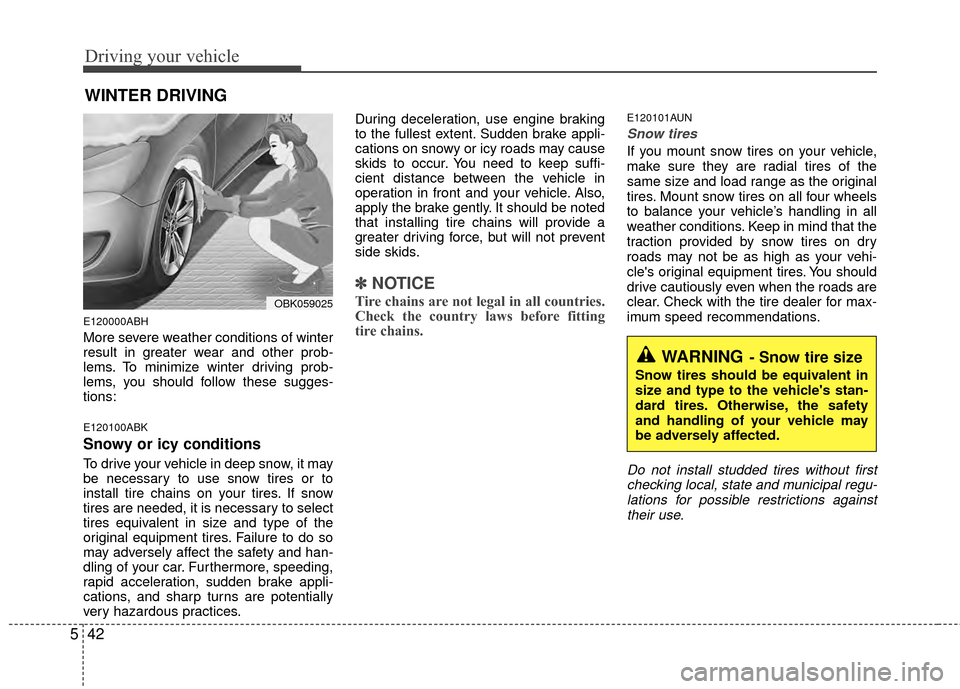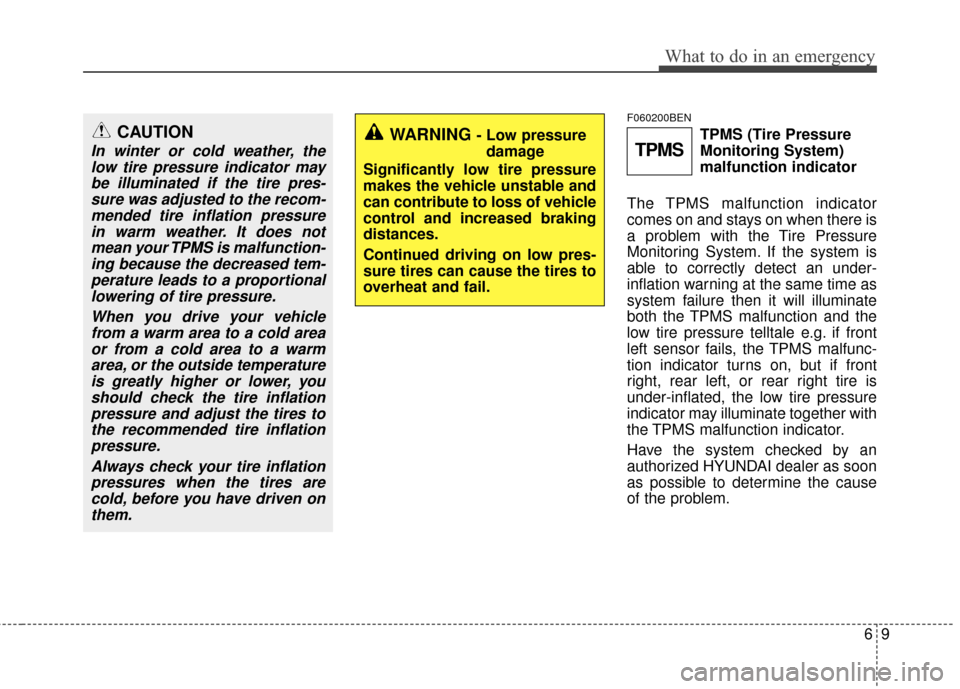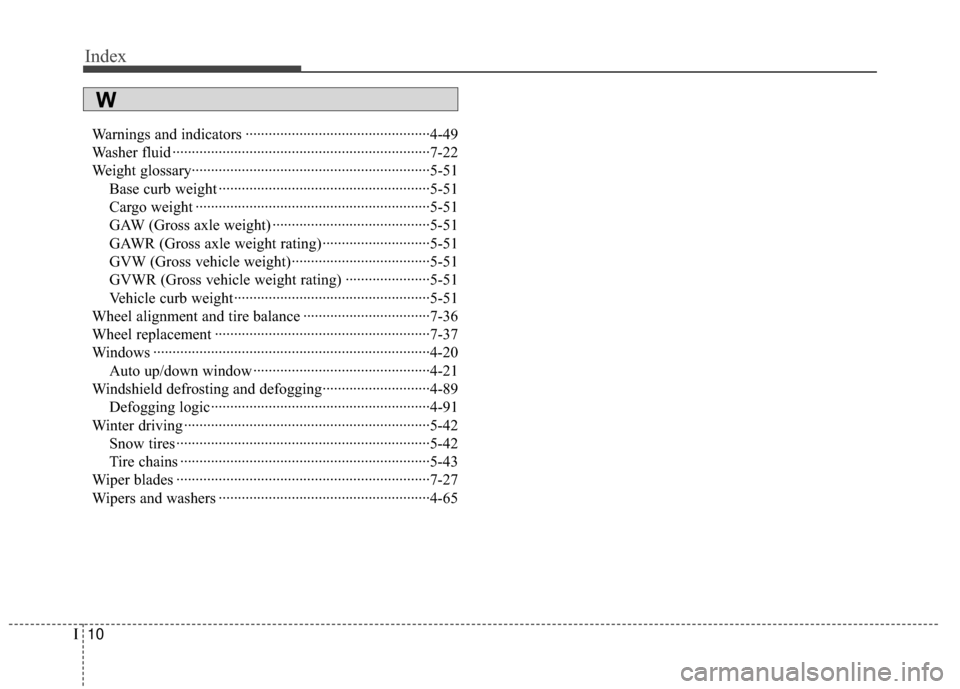winter tires Hyundai Genesis Coupe 2012 Owner's Manual
[x] Cancel search | Manufacturer: HYUNDAI, Model Year: 2012, Model line: Genesis Coupe, Model: Hyundai Genesis Coupe 2012Pages: 391, PDF Size: 6.59 MB
Page 269 of 391

Driving your vehicle
42
5
E120000ABH
More severe weather conditions of winter
result in greater wear and other prob-
lems. To minimize winter driving prob-
lems, you should follow these sugges-
tions:
E120100ABK
Snowy or icy conditions
To drive your vehicle in deep snow, it may
be necessary to use snow tires or to
install tire chains on your tires. If snow
tires are needed, it is necessary to select
tires equivalent in size and type of the
original equipment tires. Failure to do so
may adversely affect the safety and han-
dling of your car. Furthermore, speeding,
rapid acceleration, sudden brake appli-
cations, and sharp turns are potentially
very hazardous practices. During deceleration, use engine braking
to the fullest extent. Sudden brake appli-
cations on snowy or icy roads may cause
skids to occur. You need to keep suffi-
cient distance between the vehicle in
operation in front and your vehicle. Also,
apply the brake gently. It should be noted
that installing tire chains will provide a
greater driving force, but will not prevent
side skids.
✽ ✽
NOTICE
Tire chains are not legal in all countries.
Check the country laws before fitting
tire chains.
E120101AUN
Snow tires
If you mount snow tires on your vehicle,
make sure they are radial tires of the
same size and load range as the original
tires. Mount snow tires on all four wheels
to balance your vehicle’s handling in all
weather conditions. Keep in mind that the
traction provided by snow tires on dry
roads may not be as high as your vehi-
cle's original equipment tires. You should
drive cautiously even when the roads are
clear. Check with the tire dealer for max-
imum speed recommendations.
Do not install studded tires without first
checking local, state and municipal regu-lations for possible restrictions againsttheir use.
WINTER DRIVING
WARNING- Snow tire size
Snow tires should be equivalent in
size and type to the vehicle's stan-
dard tires. Otherwise, the safety
and handling of your vehicle may
be adversely affected.
OBK059025
Page 288 of 391

69
What to do in an emergency
F060200BEN
TPMS (Tire Pressure
Monitoring System)
malfunction indicator
The TPMS malfunction indicator
comes on and stays on when there is
a problem with the Tire Pressure
Monitoring System. If the system is
able to correctly detect an under-
inflation warning at the same time as
system failure then it will illuminate
both the TPMS malfunction and the
low tire pressure telltale e.g. if front
left sensor fails, the TPMS malfunc-
tion indicator turns on, but if front
right, rear left, or rear right tire is
under-inflated, the low tire pressure
indicator may illuminate together with
the TPMS malfunction indicator.
Have the system checked by an
authorized HYUNDAI dealer as soon
as possible to determine the cause
of the problem.WARNING - Low pressure damage
Significantly low tire pressure
makes the vehicle unstable and
can contribute to loss of vehicle
control and increased braking
distances.
Continued driving on low pres-
sure tires can cause the tires to
overheat and fail.CAUTION
In winter or cold weather, the low tire pressure indicator maybe illuminated if the tire pres-sure was adjusted to the recom-mended tire inflation pressurein warm weather. It does notmean your TPMS is malfunction-ing because the decreased tem-perature leads to a proportionallowering of tire pressure.
When you drive your vehiclefrom a warm area to a cold areaor from a cold area to a warmarea, or the outside temperatureis greatly higher or lower, youshould check the tire inflationpressure and adjust the tires tothe recommended tire inflationpressure.
Always check your tire inflationpressures when the tires arecold, before you have driven onthem.TPMS
Page 391 of 391

Index
10I
Warnings and indicators ··················\
··················\
············4-49
Washer fluid ··················\
··················\
··················\
·············7-22
Weight glossary··················\
··················\
··················\
········5-51Base curb weight ··················\
··················\
··················\
·5-51
Cargo weight ··················\
··················\
··················\
·······5-51
GAW (Gross axle weight) ··················\
··················\
·····5-51
GAWR (Gross axle weight rating)··················\
··········5-51
GVW (Gross vehicle weight)··················\
··················\
5-51
GVWR (Gross vehicle weight rating) ··················\
····5-51
Vehicle curb weight··················\
··················\
···············5-51
Wheel alignment and tire balance ··················\
···············7-36
Wheel replacement ··················\
··················\
··················\
··7-37
Windows ··················\
··················\
··················\
··················\
4-20 Auto up/down window ··················\
··················\
··········4-21
Windshield defrosting and defogging··················\
··········4-89 Defogging logic··················\
··················\
··················\
···4-91
Winter driving ··················\
··················\
··················\
··········5-42 Snow tires ··················\
··················\
··················\
············5-42
Tire chains ··················\
··················\
··················\
···········5-43
Wiper blades ··················\
··················\
··················\
············7-27
Wipers and washers ··················\
··················\
··················\
·4-65
W